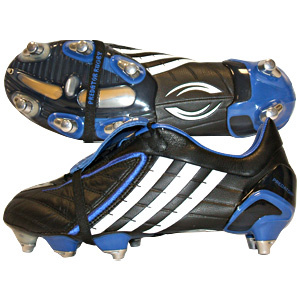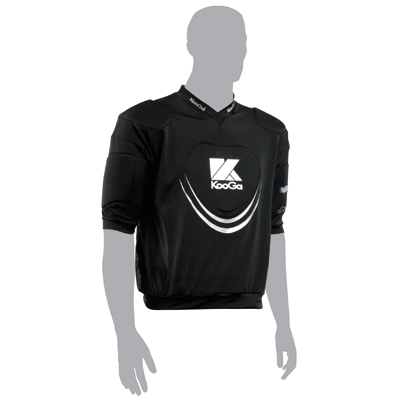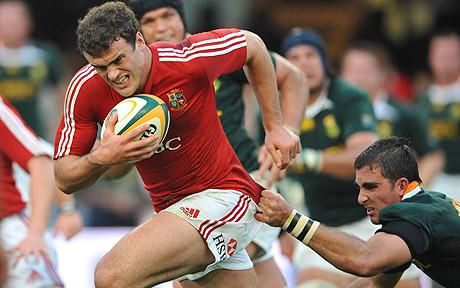Rugby Union Equipment
A traditional rugby union kit consists of a collared jersey, shorts, long socks and boots with studs. Some modest padding is allowed on the head, shoulders and collarbone, but it must be sufficiently light, thin and compressible to meet IRB standards. Most players also opt to wear a mouthguard to guard against concussion and chipping of the teeth.
Rugby Jerseys

Rugby jerseys need to be able to take plenty of tugging and pulling. They also need to be lightweight, comfortable and strong—all at the same time. Modern shirts use new lightweight water-resistant, synthetic fibers. The tight forwards wear shirts that have panels for their team-mates to grab onto.
The back of a jersey will usually have the player's position number and sometimes their surname printed above it. The team logo traditionally will be placed on one side of the upper chest. Sponsor logos and club competition logo may also be included in the design. More modern shirts, uncommon outside the highest levels of the game, are now skin-tight. They are designed to remove sweat and heat more effectively and be more difficult for an opponent to grab.
Rugby Shorts
Rugby shorts are traditionally made from cotton, designed to take the strains of rugby union. Some second row forwards now use special line-out shorts which have reinforced stitching to help them to get lifted in the line-out (although most competent jumpers will insist on being lifted by the thighs, rather than the shorts, in order to obtain a higher lift). Additionally, they are typically less stretchy, and have a shorter inseam than traditional athletic shorts so that when players bind to each other, they remain tight to one and other.
Rugby Boots

Traditionally, rugby boots were of a high cut above the ankle. Over the years, such boots have become less common, although many players still wear mid-cut boots, just below the ankle. Additional ankle support was seen as appropriate given the nature of the game, particularly the stresses of forward play, and the amount of physical contact involved. Higher cut boots also provided some protection against knocks.
Modern boots are now much more similarly styled to football boots, with a low cut offering minimal ankle support but maximum flexibility with minimum weight.
It is essential for safety considerations, particularly in the scrum, that forwards wear boots with studs. The studs may be metal (aluminium) or plastic and must conform to Regulation 12 of the IRB. This regulation dictates the permissible dimensions of the studs and also defines a standard for the hardness of the material. Backs would be advised on most ground types to wear boots with some form of stud, to ensure adequate grip when changing direction.
Generally there are two types of stud pattern worn: the 8 stud or the 6 stud. The 8 stud is most often worn by the tight forwards (props, hooker and locks) to provide them with extra grip for scrummaging and mauling. The 6 stud is worn by backs as it allows for more agility and quicker movement around the field. Plastic "blade" studs, common in football, are an increasingly frequent choice among backs.
Body Protection

Shoulder padding and protective vests are now becoming more commonly worn by players. The extent of the padding is limited by Regulation 12 of the International Rugby Board. This specifies that shoulder padding will cover the shoulder and collar bone only and extend from the neck to a maximum of 2 cm down the upper arm.
The padding is intended to give some protection to the bony prominences of the shoulder and clavicle. Padding on the chest and biceps are expressly forbidden (although permitted in Rugby League). All padded vests for use in rugby union must carry an IRB approval logo.
Women players may also wear chest pads, also of soft, thin material. This is typically worn as part of a shoulder pad vest.
Players may use fingerless gloves (also known as "mitts") to better grip the ball. Shin guards may also be worn under the socks, but only made of non-rigid fabric. Hard plastic or metal are prohibited in rugby kit. Any protective equipment that may cause injury to another player is prohibited. No form of metal is allowed in any rugby kit, except for studs on boots.
Headgear

Traditionally in rugby union, the only form of headgear that was worn was the "scrum cap". This was intended simply to protect the ears of a player who is engaged in the scrum. This aimed to prevent swollen ears, which, if left untreated, led to the condition commonly known as cauliflower ears. The traditional scrum cap was constructed of a thin cloth helmet with padding over the ears, held in place by a strap. Buckles are not permitted. Often players will opt for a thin strip of foam or cloth and electrical tape wrapped around the ears like a head band.
Since the early 1990s, other players have taken to wearing padded headgear. This is intended to protect from cuts and head injuries that can occur from incidental contact in tackles or at rucks. The headgear is strictly defined by Regulation 12 of the IRB as being made of soft, thin materials. Solid materials, such as plastics, are expressly forbidden. Regulation 12 also gives details regarding the testing standards for this headgear. All headgear to be worn in rugby union must carry an IRB approval logo. Whilst they may prevent some cuts and abrasions, such headgear has not been shown to reduce concussive injury. Additionally lightly padded headgear such as a scrum cap greatly reduces the pain that occurs when players knock heads.
Mouthguard
An essential part of the safety equipment needed for rugby is the mouthguard. It protects the teeth, gums and prevents a player from biting their tongue. It can reduce both damage around the jaw and the chances of concussion.
The best mouthguards are made by a dentist. A mould of the mouth is first taken and then the mouthguard is cast around this mould, providing a tight fit in the mouth and around the teeth. Unmoulded rubber mouthguards, which one can mould in hot water, are also available.
This article is licensed under the GNU Free Documentation License. It uses material from the Wikipedia article "Rugby Union" at http://en.wikipedia.org/wiki/Rugby_union_equipment.





